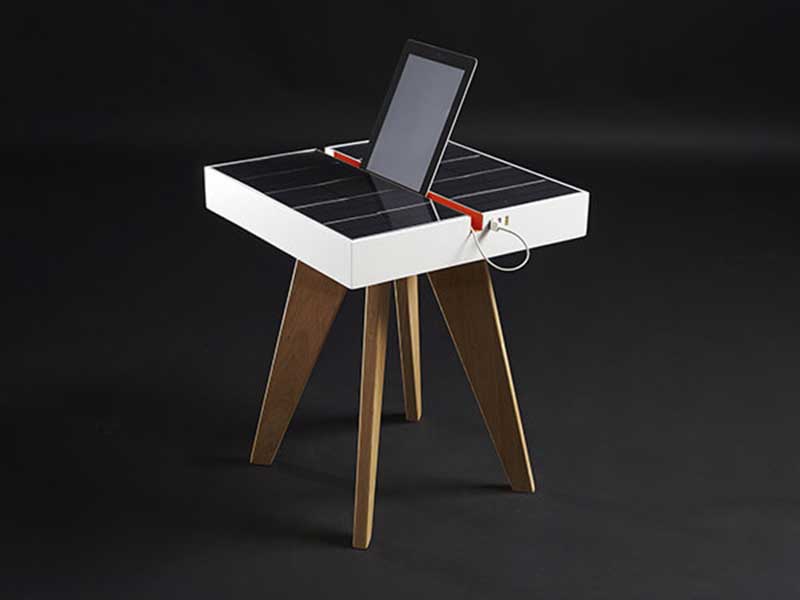- Imagine a table that detects your mood and intentions… and shape-shifts accordingly
- Furniture that charges our devices will spell the end of dead batteries
- Nike’s Microclimate Chair helps keep athletes fresh and in top shape
- With 4D printing technology, your new furniture can actually assemble itself
- These chairs – ‘bred’ from DNA – will blow your mind
Does shape-shifting furniture, device-charging furniture and even breeding furniture with ‘DNA’ sound sci-fi to you? It’s all happening already. Soon, we can put our smartphones down on a table and they will be charged automatically. We will also no longer need a separate arm chair and a couch and a bed and dining room chairs as they will all be rolled into one space-saving, shape-shifting item – some of which can even self-assemble.
Imagine a table that detects your mood and intentions… and shape-shifts accordingly
Imagine a table shape-shifting its surface – depending on how you feel or what your intentions are? Introducing the TransFORM table, invented by the Michigan Institute of Technology (MIT), designed by Tangible Media Lab and showcased at the Lexus Design Amazing exhibition in Milan. It is the perfect example of how interface design will enable us to connect and communicate with everything – further blurring the lines between human and machine. The TransFORM is made from thousands of little squares, each of them connected to a motor under its surface. The table is able to sense what your intentions are and can instantly create, let’s say, a bowl when you want to put fruit down on the table, or a support for your tablet. It can communicate – in tangible form – the message on your smartphone and it can remind you to take you keys with you by raising and shaking the section on the table where you put them down.
Translating this type of technology and applying it to functional furniture can result in designs such as Lift-bit; the first Internet of Things sofa designed by Italian architect and MIT professor Carlo Ratti in collaboration with Swiss furniture brand Vitra. The Lift-bit is made up of multiple modular seats with sensors and linear motors that enable the elements to be adjusted into different configurations with an app or hand gestures. The elements all communicate with each other and when you move your hand over the seat you can lower or raise the elements – creating either an upright stool, a comfy chair or a reclining sofa. With added modules, you can create larger surfaces that can be adjusted to your liking. When not in use, the systems even gets ‘bored’ and shape shifts on its own as if to say: “hey, I’m still here!”
Furniture that charges our devices will spell the end of dead batteries
In our society where we are always connected, noticing the battery icon of our device reduced to only one bar – with no plug or charger in sight – sends most people into a flat panic. Luckily there are quite a few designers who have given this predicament a lot of thought and built technology into tables to enable them to function as charging stations for smart devices.
The Lucio table by the Italian design firm Studio Natural is a great example of next level power generating furniture. This small side table has a top made from solar panels that converts not only solar but also artificial light into power. The table comes complete with USB connections that supply free, regenerated energy, making this piece valuable from a cost perspective but also because of its eco-friendliness. Since the versatile, free standing Lucio table generates literally all of its energy from light, it can be stationed anywhere and work autonomously; without any need for plugs. The Lucio table’s sleek design boasts wooden legs and a smooth, eye catching solar cell surface. The orange split in the middle can hold and charge your smartphone, tablet or any other mobile device in need of some battery juice.
Another charging table comes from Dutch design firm Studio Mak. The Cloud Table is a nifty piece of furniture made from poplar wood, containing integrated media technologies and embedded wireless charging pads. The beautifully designed Cloud Table can be stationed in public spaces and has space for larger groups of people in a variety of seating arrangements. You can lay down your smartphone or tablet on the flowingly shaped surface of the table and revive the device’s battery without the need for charging cables and sockets. Furniture like this fulfils multiple functions; from a space where friends have coffee or lunch to a workspace where colleagues sit and have strategy meetings – socially connecting people in physical as well as virtual spaces.

Nike’s Microclimate Chair helps keep athletes fresh and in top shape
In partnership with Nike for its Nature of Motion exhibition at the Design Week in Milan, LA-based architect Greg Lynn designed the Microclimate Chair- a futuristic sports recovery chair made from rigid carbon weave and flexible carbon tape. The surface of the futuristic looking chair contains weight and heat sensors that enable it to cool down or heat up specific sections of the body. It even monitors the amount of fluids an athlete loses during sports performance. The core temperature of the athlete can be decreased by cooling his spine. His thighs and calves can be warmed so that they don’t cramp. The Microclimate Chair also distributes air which is diffused across the surface of the seat, leading to a reduction in perspiration levels. The chair could potentially give athletes enormous performance advantages but it was primarily designed for the Nature of Motion exhibition and there is no intention of commercialising it. Potential uses could however include team benches or training room equipment for assistance during game breaks. Perhaps the most affluent athletes may be able to get their hands on one for personal use – should Nike decide to make them available commercially.
With 4D printing technology, your new furniture can actually assemble itself
4D printing technology is basically 3D printing technology with the added dimension of time. To turn 3D into 4D, the printer needs to be fed a geometric code, based on the dimensions and angles of the object but also data on how the object should alter its shape when exposed to external factors such as movement, temperature change or water. Computational architect Skylar Tibbits of the MITs Self Assembly Lab has been designing various materials that are able to morph into functional objects – basically assembling themselves – when exposed to water. As part of one of his MIT projects, in collaboration with Italian design studio Wood-Skin, he developed the Programmable Table. Using simple furniture design combined with high-tech materials science, a material made up of wood and tensile fabric uses tessellation to fold flat and then pop into shape. No allen wrenches, wooden pegs or complicated instructions required – just a bit of a nudge. The interlocking wood triangles lend the table flexibility as well as durability while the fabric enables the table to basically snap into shape. These new technologies could soon spell the end of the IKEA flatpacks which are sometimes so complicated to assemble that some couples use them to test their relationship.
These chairs – ‘bred’ from DNA – will blow your mind
With the exponential developments in 3D and 4D printing technologies, designers are increasingly wondering to which extent technology is able to assist in terms of design perfection. Well, applying the science of genetic engineering to inanimate objects, we might just be on the right track. The FormNation team – founded by designer Jan Habraken – developed the ‘ChairGenics’ hypothesis: “If we crossbreed individual chairs that have desirable traits, would we be able to create the ultimate chair?” Well, bringing various generations of chairs to life, using computers and then getting them to ‘mate’ with each other – using various DNA pairings – they actually managed to accomplish this. The genetic makeup of chairs in general, such as durability, ergonomics, construction, aesthetics and costs, were all taken into account. For this particular project, FormNation collaborated with Uformia (a Californian-Norwegian startup specialising in 3D modelling) and Mathieu Sanches (morphing specialist), to develop software that can mimic the genetic world. With this software, they were able to compare two objects and create morphs based on the objects’ mathematical middle. This resulted in never before imagined designs and shapes. Some morphs displayed ‘breeding complications’ however; of some of the chairs, for instance, the seat remained while arm rests vanished. Remarkably, the team also encountered tendencies toward ‘obesity’. By avoiding inbreeding and controlling the growth in the body parts, these tendencies were eventually counteracted. The functional models were bred further and eventually produced a ‘family tree’ of chairs. The first generation ChairGenics prototype chairs are being 3D printed and plans are underway for large-scale aluminium reconstruction of these ‘ultimate chairs’.
As technology becomes increasingly important in our lives, it will be interesting to see how designers turn to sophisticated yet inconspicuous technologies to create not only comfortable and stylish but also high-tech and multifunctional furniture.




